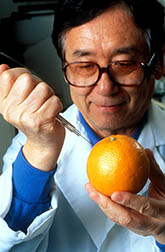Citrus Bitterness, Begone!
|
|
Troublesome compounds called limonin and nomilin can make even the freshest citrus fruit taste bitter.
Some kinds of citrus trees thwart these natural chemicals by neatly attaching a sugar (glucose) molecule onto them. This simple maneuver converts limonin and nomilin to nonbitter compounds called limonoid glucosides.
ARS chemist Shin Hasegawa and colleagues were the first to discover limonoid glucosides about 7 years ago. So far, they've uncovered about 20 of these compounds.
Now, Hasegawa and co-researcher Wan-Jean Hsu want to genetically engineer citrus trees to boost the rate at which they convert the bitter parent compounds into benign limonoid glucosides. Tomorrow's genetically engineered navel orange trees, for instance, would naturally debitter their own fruit.
Currently, limonin causes navel orange juice to turn bitter and unmarketable just hours after it's squeezed.
The bitterness reaction, says Hasegawa, can also be triggered by freezing weather and costs navel orange growers in California about $8 million a year in lost sales. Hasegawa and Hsu are based at the ARS Western Regional Research Center in Albany, California.
To sweeten citrus of the future, Hasegawa wants to find the gene that cues trees to hook a sugar molecule onto limonin or nomilin. Genes do that by instructing the tree to form an enzyme that carries out the task.
Hasegawa has tracked down an enzyme in navel oranges that fastens a glucose molecule to limonin.
"This enzyme, limonoid UDP-D-glucose transferase," he says, "is the product of a gene, so it can lead us back to it." He did the work with chemist Charles G. Suhayda and with Mitsuo Omura of the Japanese government's Fruit Tree Research Station in Okitsu, Shimizu, Japan.
Hasegawa estimates his Okitsu collaborators may pinpoint the debittering gene by the end of this year. Once that happens, the biotechnologists will try to rebuild the gene, to make it more powerful. Then they will slip it into citrus cells that are growing in laboratory petri dishes. The researchers can nurture the cells into healthy young trees with the retooled gene working inside.
Besides blunting bitterness of high-tech navel oranges of the future, limonoid glucosides may be featured in an innovative beverage for Japanese consumers.
One of Japan's largest producers of fruit juices, teas, and other drinks intends to produce an updated orange juice that offers concentrated extracts of such limonoid glucosides as limonin 17-beta-D-glucopyranoside. The company, a part of Wakayama Prefectural Federation of Agricultural Cooperatives, became interested in the debittering compounds when work at Baylor University showed that the chemicals reduced the size of cancerous oral tumors in laboratory animals.
Hasegawa and colleagues discovered limonin 17-beta-D-glucopyranoside and furnished vials of the tasteless, odorless white concentrate for the Baylor experiments. Edward G. Miller, who is in the Baylor College of Dentistry, conducted the tests.
Wakayama Corporation will use limonoid glucosides extracted from juice-processing leftovers, including peels, seeds, pulp, and albedo—the thin white skin that encloses citrus segments.
The new product, not yet named, will boast about three times more limonoid glucosides than a typical 8-ounce glass of orange juice. Wakayama plans to begin test-marketing the juice-based drink this year. — By Marcia Wood, ARS.
USDA-ARS Process Chemistry and Engineering Research Unit, Western Regional Research Center, 800 Buchanan St., Albany, CA 94710; phone (510) 559-5819, fax (510)559-5777.







